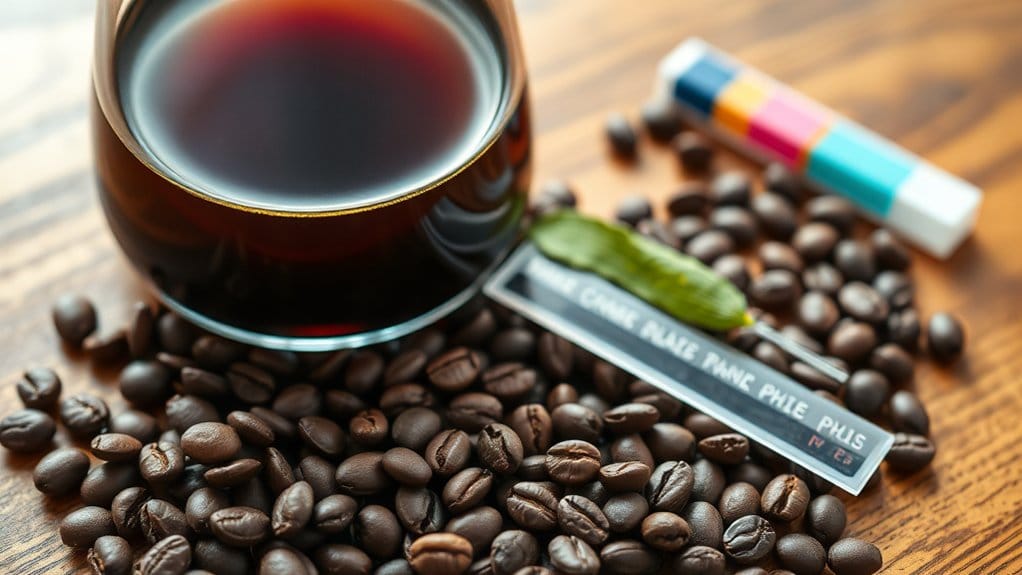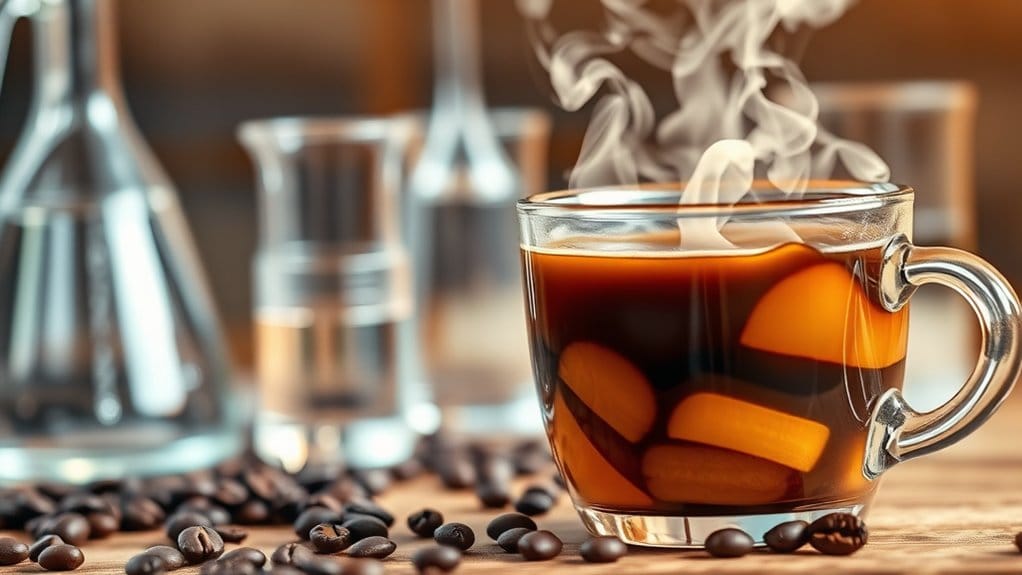Physical Address
304 North Cardinal St.
Dorchester Center, MA 02124
Physical Address
304 North Cardinal St.
Dorchester Center, MA 02124

Water’s pH plays a huge role in your coffee’s flavor. When it’s between 6.5 and 7.5, you get a lively cup that highlights all those delicious aromas. If it’s too high, your coffee might taste flat and dull. Think of it like trying to enjoy a cake without enough sugar! Plus, different water sources can surprise you with unique flavors. Stick around to learn how adjusting these brewing parameters can further improve your coffee experience!

Have you ever wondered why the water you use matters so much when brewing coffee? The pH level of your water has a huge impact. It ranges from 0 to 14, with neutral water sitting at around 7. For brewing, you want that ideal pH between 6.5 and 7.5. This slight acidity helps you pull out delicious flavors, whereas higher pH can turn your coffee flat. Imagine sipping a cup of joe that lacks all its zing! Additionally, using water with optimal pH ensures that the coffee retains its delightful aromas and complex flavor profile. Using mineral water can bring its own quirks, too—like a salty taste if it’s high in sodium. It’s also important to note that water quality significantly influences the extraction of flavors from your coffee grounds. So, next time you brew, remember: good coffee starts with great water! Treat it well, and you’ll taste the difference.
When you think about brewing that perfect cup of coffee, the temperature of your water plays a starring role in the flavor drama unfolding in your mug.
Higher temperatures, around 90°C, extract more acids and create a richer body, but they can mask the bright acidity you love. Conversely, lower temperatures result in a lighter brew, letting those tangy notes shine through. Ideal extraction temperature is critical in finding the right balance between acidity and body. Additionally, higher brew temperatures can lead to increased extraction yields, further impacting the flavor profile.
It’s important to note that coffee acidity is typically around a pH of 5.2, influencing the overall taste of your brew. Ever tried cold brew? It’s smooth and mellow, largely due to fewer acidic compounds being released.

Even though many people might think of coffee’s flavor coming solely from the beans, the truth is, water quality plays a huge role in developing that perfect cup.
Have you ever sipped coffee and wondered if it tasted a bit off? That might be tap water’s fault! Minerals like magnesium and calcium help extract flavors but too much can make it bitter—yikes! Utilizing filtered water can clear away impurities, giving your brew a cleaner taste. Think about it: would you drink muddy water?
Isn’t it interesting how something as simple as pH levels can make a huge difference in your coffee?
When brewing, aim for a pH between 7 and 8.5, the sweet spot for extracting balanced flavor. If your water’s pH is too high, you might end up with brightly chalky notes instead of smooth goodness.
Think of your brewing water as the perfect movement partner; it should complement the coffee, not overshadow it.
Remember, Arabica beans are more acidic than Robusta, so tweak your pH based on the roast type! With a little experimentation, you’ll soon find your ideal brewing water pH.
Trust me, your taste buds will thank you, and maybe your coffee shop friends will be a bit jealous too!

Your choice of water can dramatically shape your coffee experience, just like the perfect song can make or break a movement party.
Think about tap water, which often hides minerals and contaminants that can muddle your brew. Then there’s spring water, rich in magnesium and calcium, adding delightful sweetness and body.
Distilled water strips it all away, leading to a cleaner but simpler taste. Hard water can improve flavor extraction, whereas soft water might leave your cup flat.
The right balance of minerals brings out creamy notes or fruity flavors. So, why not experiment with different waters? You might uncover a flavor revelation that twirls on your palate like a catchy tune!
Grab that kettle and let’s plunge into it!
How can you tweak your brewing parameters to get the perfect balance of acidity in your coffee?
Start by experimenting with grind size. A finer grind exposes more coffee to water, pulling out that zingy acidity. If you prefer a fuller flavor, try a French press for a smoother cup.
Adjusting water temperature is key too—aim for around 204°F to really improve acidity!
Don’t forget brew time; shorter times can keep your coffee bright and lively, whereas longer extraction might add bitterness instead.
And remember, lighter roasts typically bring out more acidity, whereas darker ones soften those sharp notes. Additionally, grind size can greatly influence extraction balance, so be mindful of its effect on flavor complexity.

Even though water often takes a backseat in the coffee-making process, it plays a crucial role in shaping the flavors you experience.
Imagine this: about 98-99% of your brewed coffee is water! Its temperature affects how well it extracts flavors from the coffee grounds. Too hot, and you risk over-extraction, leading to bitterness. Too cold? You’ll end up with sour notes instead.
Water pH also matters. Ideally, you want it around 7, so the coffee’s natural flavors shine. Minerals like calcium and magnesium further improve that flavor choreography, adding complexity to each sip. Additionally, understanding your individual sensitivity to caffeine can help you optimize your coffee enjoyment without compromising sleep quality.
Coffee acidity can irritate your digestive system, possibly worsening IBS, acid reflux, and heartburn. Experimenting with lower-acid options like dark roasts or cold brews might help alleviate some of those uncomfortable symptoms.
If you’re looking for low-acid coffee, choose Robusta beans, Brazilian Arabica, or Indonesian coffees like Sumatra. Dark roasts are likewise a great option, as they reduce acidity and provide a sturdier taste experience.
Yes, acidity in coffee can improve flavor. It brightens fruity notes, adds complexity, and balances bitterness, making each sip more enjoyable. You’ll appreciate how it amplifies sweetness, creating a richer sensory experience.
To avoid acidity in coffee, try cold brewing, use hard water, adjust brew time and temperature, or choose low-acid beans. Coarser grinds and paper filters additionally help create a smoother, less acidic cup.
Altitude directly impacts coffee acidity levels by affecting caffeine and organic acid concentrations. Higher altitudes yield beans with lower caffeine and unique flavor profiles, whereas lower altitudes often boost acidity through higher chlorogenic acid content.